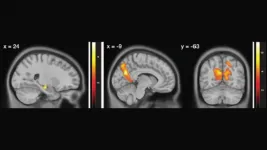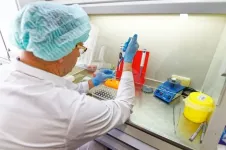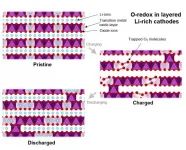Deep dive into bioarchaeological data reveals Mediterranean migration trends over 8,000 years
2021-03-01
(Press-News.org) A team of international researchers led by a Florida State University assistant professor has analyzed reams of data from the Neolithic to Late Roman period looking at migration patterns across the Mediterranean and found that despite evidence of cultural connections, there's little evidence of massive migration across the region.
"Because of the prevailing scholarly attitude of the 'connected' Mediterranean -- one with high degrees of mobility and migration that drive the archaeological patterns we see -- we'd imagined we'd see comparatively high levels of migration reflected in the strontium isotope data," said Thomas Leppard, assistant professor of anthropology at Florida State. "That instead we saw low levels of migration, and that these in fact decreased over time, was very surprising."
Leppard and his colleagues found that from about 7,500 BC to AD 500, migration rates ranged from about 6% to 9% of the population within the dataset. These rates seem to have decreased over time.
The research is published in the Journal of Mediterranean Archaeology.
Many historians and archaeologists consider the Mediterranean basin to have been interconnected for much of its history. However, that theory is largely built on material culture that suggests such connections - for example, Greek-looking pots in Sicily in the Late Bronze Age, Arabic coins in Medieval Sardinia, or Roman-style dining sets in 2nd century AD Portugal.
Leppard wondered if the same pattern would be obvious if they brought human biochemistry into the mix.
For several years, scientists have been able to understand individual life histories by analyzing the chemistry of human remains. In humans, bodily tissues, including most bones, remake themselves constantly so that their chemical composition reflects their current environment. However, dental enamel and a small skull bone called the petrous portion are extremely hard and don't remodel, so once a human reaches adulthood, the isotope ratios in those two areas of the body don't change.
"As a result, if you spend childhood somewhere, and then move as an adult to a different place with different underlying chemistry, we can see a difference in the chemistry - and critically in the ratios of different strontium isotopes - between your dental enamel and your other bones," Leppard said. "If, however, you grew up and died in the same location, the ratios will be the same. That means we can start to quantify percentages of locals, and percentages of nonlocals in a given area."
Archaeologists have employed this technique for a while in the Mediterranean, but the sample sizes are generally very small because the experiments are expensive and there often aren't many samples of human remains. Leppard and his colleagues compiled all the data from many smaller experiments capturing a large time frame and re-analyzed it.
He cautioned that this is a starting place to assess the migration patterns of this region.
"It's important to say that migration is only one aspect of human mobility; we can't access seasonal or habitual mobility with this method, for example," Leppard said. "That said, we thought this would be a powerful method for assessing large-scale trends in Mediterranean migration across time. That these trends don't really match the current scholarship should generate productive debate and prompt new research."
INFORMATION:
Leppard's co-authors are Carmen Esposito, a doctoral student at Queen's University in Belfast; and Massimiliano Esposito, a former doctoral student from Imperial College London.
[Attachments] See images for this press release:

ELSE PRESS RELEASES FROM THIS DATE:
2021-03-01
Invasive alien species, defined as animals and plants that breed and disperse in a landscape beyond their native range, have negative environmental, social, and economic impacts. One example among many is the forage grass genus Brachiaria, originally African and introduced to Brazil to form cattle pasture. It has become a major threat to the survival of native species and biodiversity at several spatial scales.
Complete eradication of invasive species is often impracticable. Attempts to do so have had undesirable consequences and even been damaging because merely withdrawing an invasive ...
2021-03-01
Too much activity in the hippocampus may cause navigation impairments seen in aging adults, according to new research published in JNeurosci.
Spatial navigation is one of the cognitive abilities that declines sharply in old age. Older adults often have difficulty navigating new environments and will choose to stick with familiar ones. Plus, key regions in the brain's navigation circuit are some of the first affected by Alzheimer's disease. In a recent study, Diersch et al. examined the neural mechanism behind this decline in spatial learning.
In the study, younger ...
2021-03-01
A single letter difference in a single gene, inherited from both parents, spells a lifetime of anemia and pain for 20 million people, mostly of African ancestry, worldwide. Sickle cell disease (SCD) causes red blood cells to assume a sickle shape and jam in capillaries, cutting off oxygen to lungs, brain, bones and other organs. Despite the single genetic origin of SCD, each person's disease experience and even life expectancy depend upon where they live, and the social, physical and environmental factors they encounter.
Now, a new review published by Wiley in the journal Advanced Genetics proposes that it is ...
2021-03-01
The rapid loss of variation within species is a hidden biodiversity crisis, according to the authors of a new study looking at how this variation supports essential ecological functions and the benefits nature provides for people.
Published March 1 in Nature Ecology and Evolution, the study highlights the need to better understand and conserve variation within species in order to safeguard nature's contributions to people.
"Biodiversity means more than the number of species, and when we focus on species-level extinctions we are missing part of the story," said corresponding author Eric Palkovacs, professor of ecology and evolutionary biology at UC Santa Cruz. "Intraspecific variation is a neglected aspect of biodiversity, ...
2021-03-01
ITHACA, N.Y. - The expansion of charter schools in the 2000s led to an increase in school segregation and a slight decline in residential segregation, according to new research from Cornell University providing the first national estimates of the diverging trends.
According to the study, the average district to expand charter school enrollment between 2000 and 2010 experienced a 12% increase in white-Black school segregation and a 2% decrease in white-Black residential segregation.
The patterns moved in opposite directions, the research found, because charter ...
2021-03-01
Scientists from the Stanley Manne Children's Research Institute at Ann & Robert H. Lurie Children's Hospital of Chicago found that a region within the DNA of the cancer-promoting GLI1 gene is directly responsible for regulating this gene's expression. These findings, published in the journal Stem Cells, imply that this region within GLI1 could potentially be targeted as cancer treatment, since turning off GLI1 would interrupt excessive cell division characteristic of cancer.
"From previous research, we know that GLI1 drives the unrelenting cell proliferation that is responsible for many cancers, and that this gene also stimulates its own expression," says co-senior author Philip Iannaccone, MD, PhD, Professor Emeritus at the Manne Research Institute at Lurie Children's and Northwestern ...
2021-03-01
Scientists from Far Eastern Federal University (FEFU) together with Russian and German colleagues, continue studying antitumor compounds synthesized based on bioactive molecules isolated from a sea sponge. One of them fights cancer cells resistant to standard chemotherapy, and at the same time has an interesting dual mechanism of action. A related article appears in Marine Drugs.
Scientists have tested the biological effect of the marine alkaloid 3,10-dibromofascaplysin on various prostate cancer cells, including those resistant to standard docetaxel-based chemotherapy. ...
2021-03-01
CORVALLIS, Ore. - In tropical oceans, a combination of sunlight and weak winds drives up surface temperatures in the afternoon, increasing atmospheric turbulence, unprecedented new observational data collected by an Oregon State University researcher shows.
The new findings could have important implications for weather forecasting and climate modeling, said Simon de Szoeke, a professor in OSU's College of Earth, Ocean, and Atmospheric Sciences and the lead author of the study.
"The ocean warms in the afternoon by just a degree or two, but it is an effect that has largely been ignored," said de Szoeke. ...
2021-03-01
HARWELL, UK (1 March 2021) Scientists based at the University of Oxford as part of the Faraday Institution CATMAT project researching next-generation cathode materials have made a significant advance in understanding oxygen-redox processes involved in lithium-rich cathode materials. The paper, published in Nature Energy, proposes strategies that offer potential routes to increase the energy density of lithium-ion batteries.
"In the ever more difficult quest to make incremental improvements to Li-ion battery energy density, being able to harness the potential of oxygen-redox cathodes and the bigger improvements they offer relative to the nickel rich cathodes in commercial use today is potentially significant," Prof Peter Bruce, University ...
2021-03-01
Childhood cancer and its treatment can result in cognitive struggles. Scientists atSt. Jude Children's Research Hospital are studying the risk factors. They looked at social and economic issues in children with brain tumors treated with radiation.
These patients have the greatest risk of cognitive problems. Scientists followed a group of St. Jude patients for 10 years. The children all had conformal radiation therapy.
For each patient, researchers looked at certain factors. These included the parent's job, education level, and whether it was a single parent home. The children were from different backgrounds.
The findings show social and economic status is linked to IQ, academics, attention ...
LAST 30 PRESS RELEASES:
[Press-News.org] Deep dive into bioarchaeological data reveals Mediterranean migration trends over 8,000 years







